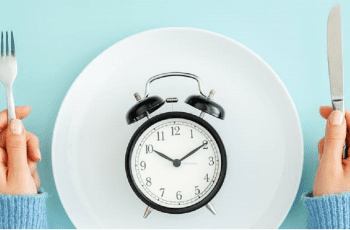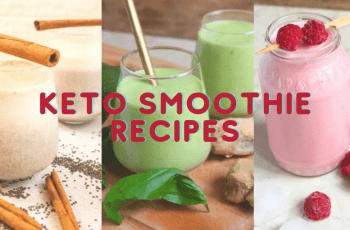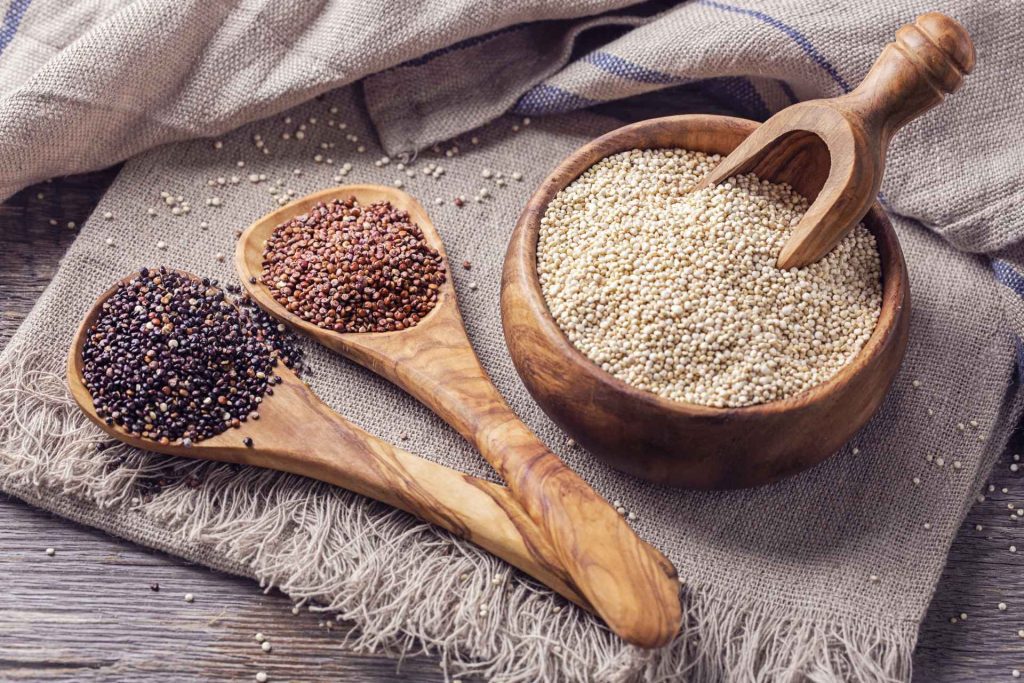
Five thousand years ago, Quinoa was grown in South America and had since become a staple in the region because of its nutritional and easy-to-prepare properties. Quinoa is known as the “mother of all grains.” As a result, it has become one of the most popular superfoods for health-conscious people worldwide. Is Quinoa good for weight loss? Keep reading.
What is quinoa?
Vitamins, minerals, and fiber are all found in the pseudo-cereal Quinoa, which is also a good source of protein. Quaker Oats are goosefoot seeds that have been ground into flour. It has a slightly nutty flavor when cooked and is fluffy and soft. Foods like bread and pasta can also be made with it.
Quinoa seeds come in a wide range of colors and varieties. But the most commonly harvested seeds are white, red, and black. Cooking time for the most common “white” quinoa is the shortest, while red quinoa is known to be the most flavorful and crunchy. Quinoa, known as “black,” has the best flavor and texture, but it also takes the longest to prepare. Quinoa is available in many colors, including yellow, grey, orange, purple, pink, green, and yellow.
Is Quinoa Healthy For you?
Vitamin B6, iron, thiamine, copper, and protein are all found in quinoa. In addition, phosphorus, manganese, magnesium, and folate are also abundant in this food. As a result of its unique nutritional profile, which includes high levels of protein and fat, as well as minerals, antioxidants, vitamins, and fatty acids, it is considered a particularly healthy snack.
5 Health benefits of quinoa
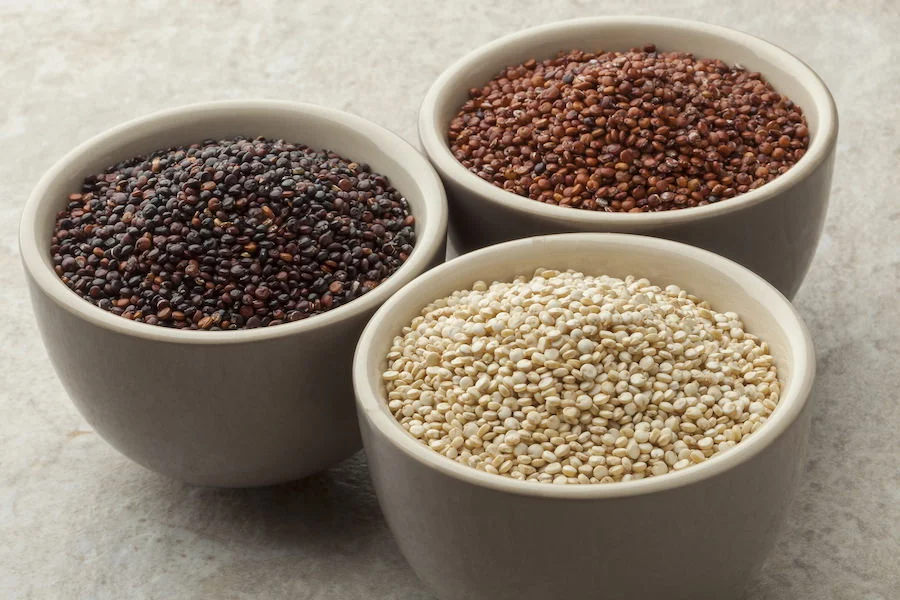
1. Naturally gluten-free
Quinoa is the best gluten-free alternative for gluten sensitivity, celiac disease, or gluten intolerance because it has a high nutrient and antioxidant content. Potato, tapioca, and corn are all gluten-free alternatives that can be substituted with quinoa. In terms of nutrition, it is superior to rice because it contains the necessary amounts of protein, calcium, iron, and fiber to ensure a well-balanced diet and meet the dietary needs of those with the condition.
2. The rich source of protein
Quinoa is one of the few plant foods that contain all nine essential amino acids, which the body cannot produce on its own, making it a complete protein food. It is a good source of lysine, methionine, and tryptophan, all necessary amino acids. Rice, corn, barley, and oats are all pale compared to the amount of protein in this food. Additionally, a diet rich in protein ensures that your blood, skin, muscle, bone, and overall health are maintained.
3. Contains high levels of minerals
Essential nutrients like potassium, magnesium, zinc, and iron are often lacking in many people’s diets. Magnesium and iron are particularly abundant in quinoa, which contains high levels of all four minerals. A high magnesium intake is associated with a lower risk of developing type 2 diabetes, improved blood sugar control, fewer headaches, muscle cramps, and restless nights.
Another nutrient, iron, is essential for a wide range of bodily functions. We need it to keep our red blood cells working correctly, maintain healthy muscle metabolism, and keep our brains functioning at their best. Iron deficiency sufferers should eat quinoa, which is rich in minerals.
4. Rich in Flavonoids
Flavonoids are found in high concentrations in quinoa. Specific antioxidants known as flavonoids have been shown to protect against osteoporosis, cardiovascular disease, and cancer. Quercetin and kaempferol, two flavonoids found in high concentrations, are good examples. It helps maintain a healthy and well-balanced state of mind by having anti-inflammatory, anti-viral, and anti-depressant properties.
5. Repairs damaged skin
The amino acid lysine, found in quinoa, is a crucial component in synthesizing collagen and elastin. It aids in the repair of sun-damaged skin and counteracts the oxidative effects of free radicals from pollution and the sun. To help with age spots and other pigment-related conditions, quinoa’s vitamin B content reduces dark melanin deposits.
Is Quinoa good for weight loss?
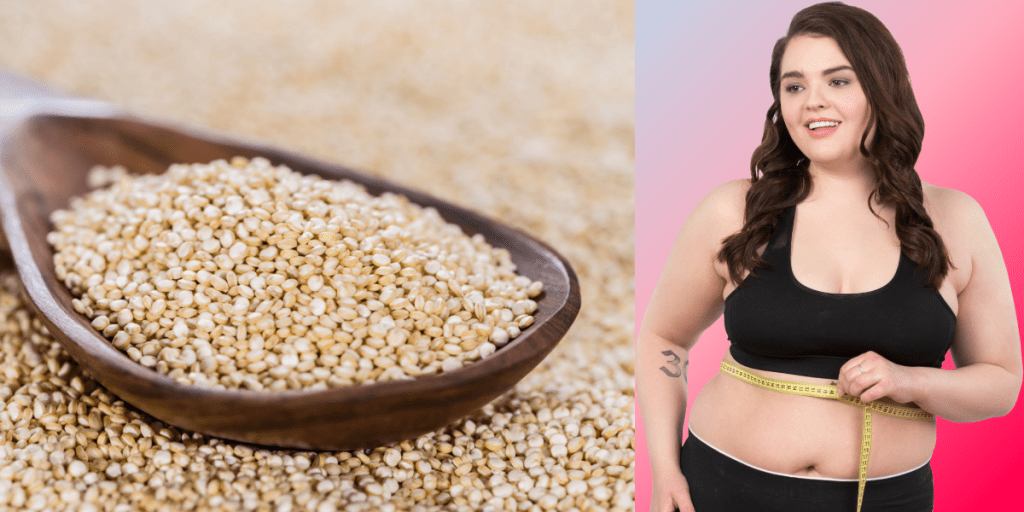
Is Quinoa good for weight loss? Because of its high insoluble fiber content, quinoa aids in weight loss by increasing the feeling of satiety. In addition to being high in fiber and protein, it boosts metabolism and reduces food cravings, lowering caloric intake. Adding protein and fiber from quinoa instead of traditional grains like rice or wheat could be a small change that aids in weight loss.
Quinoa is especially useful for vegetarians who are trying to lose weight and have difficulty finding filling foods. In addition, because of its low glycemic index (GI), quinoa is suitable for people with diabetes because it aids blood sugar regulation. For this reason, quinoa is an excellent choice for those trying to lose weight, as it reduces hunger and adds a pleasant texture to meals.
Nutrition Value of Quinoa
- Potassium: 9% of the RDA
- Phosphorus: 28% of the RDA
- Folate: 19% of the RDA
- Manganese: 58% of the RDA
- Magnesium: 30% of the RDA
- Over 10% of the RDA for vitamins B1, B2, and B6
- Small amounts of calcium, B3 (niacin), vitamin E, and omega-3 fatty acids
- Total calories: 222 Cal
- Protein: 8 gm
- Fiber: 5 gm
- Carbs: 39 gm
- Fat: 4 gm
- Copper: 18% of the RDA
- Iron: 15% of the RDA
- Zinc: 13% of the RDA.
Quinoa vs. Millets
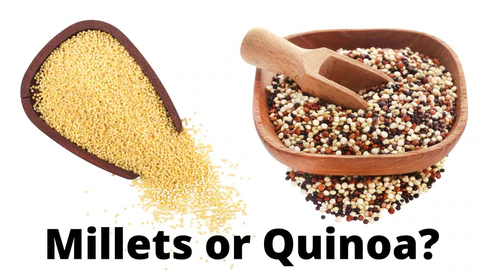
All nine essential amino acids are found in quinoa, making it a complete protein. In a half-cup serving, it provides about 6 grams of protein. The essential amino acids are absent from millets, which also have a low protein content. Although millets and quinoa differ in protein content, these grains are high in fiber and antioxidants, which protect the body from disease-causing free radicals.
Quinoa can be prepared in the same manner as rice and is ready in 15 minutes. But due to their increased size, millets are more challenging to compose. It’s like the texture of the pasta and mashed potatoes when you cook with a lot of water. Both grains have mild flavors when it comes to serving, but millets have a distinct nutty flavor and feel.
Quinoa recipes
Quinoa can be used in a variety of ways. For breakfast, lunch, or dinner, quinoa can be prepared in various ways. Quinoa can be used in place of white rice, making food preparation healthier. Quinoa can easily be substituted for white rice in your diet in the following recipe.
Quinoa Vegetable Pulao
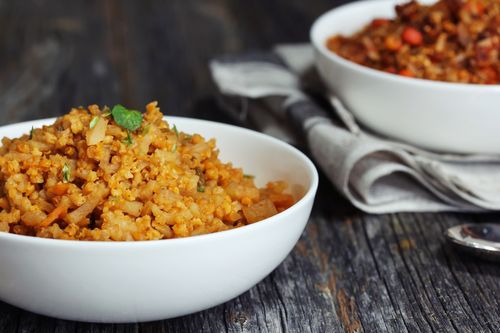
Serving size: 4-5 people
Preparation time: 15 minutes
Cooking time: 20 minutes
Ingredients:
•Quinoa – 1 cup
•Onion chopped – 1 cup
•Corn – 1/4 cup
•Chopped mixed vegetables (carrots, beans, cauliflower) – 1 cup
•Green peas – 1/4 cup
•Peanuts – 1 tbsp
•Ginger-garlic paste – 1 tbsp
•Ghee – 1 tbsp
•Cumin seeds – 1 tsp
•Cloves – 2-3
•Cinnamon -1-inch piece
•Black peppercorns – 4
•Bay leaf -1
•Salt to taste
•Turmeric powder – 1/2 tsp
•Chili powder – 1 tsp
•Garam masala – 1 tsp
•Water – 2 cups
•Lemon juice – 1 tbsp
•Coriander leaves – 1 tbsp chopped
Instructions
- In a nonstick frying pan, melt the ghee. Sauté the peanuts after they’ve been added. Make a paste with cumin seeds, whole spices, and bay leaves. Allow the seeds to sputter and wilt. Add the ginger-garlic mixture and cook for a few seconds longer. Add the onions and cook for another 30 seconds or so.
- Sauté the vegetables, including the corn and peas, for one minute more. Add the garam masala, turmeric, and chili powders now. Give it a few more seconds to cook. Add the quinoa to the sautéed vegetables after it has been thoroughly washed. Add water and salt to taste after cooking for a few seconds, then remove from heat.
- Cook for 10 to 15 minutes at low heat with the lid on. Allow the pulao to sit for five minutes before serving. Lemon juice and coriander leaves are excellent additions to the finished dish.
Summary
This gluten-free pseudo-cereal is packed with fiber, protein, and various essential micronutrients. Vegans, vegetarians, and anyone trying to eat less meat will love this protein source because it contains all nine of the body’s essential amino acids. In addition, the B vitamins in quinoa help the body’s metabolic processes, turning food into cellular energy. Heart disease is less likely when you consume foods such as quinoa because it is low in sodium, cholesterol, and blood pressure. To top it all off, it’s widely regarded as the best alternative to rice because of its high nutrient density and thus can be incorporated into any healthy diet.

